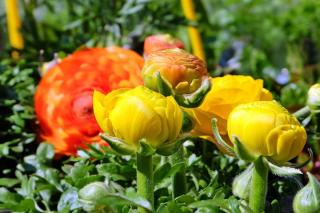

Ranunculus are marvelous right from the beginning of spring and will bloom until the beginning of summer.
Ranunculus facts to remember
Name – Ranunculus asiaticus
Family – Ranunculaceae
Type – tuberous
Height – 16 to 24 inches (40 to 60 cm)
Exposure: part sun – Soil: ordinary, drained – Flowering: mid→late spring
The planting and care is simple and it is guaranteed to produce a great decorative impact!
Ranunculus is a bulb flower that loves sun to bloom well, but it hates it when it gets too hot.
Bulbs are planted during the month of February-March at a depth of 2 to 2½ inches (5 to 6 cm).
Depending on the area you live in and the climate you have, your Ranunculus will need to be cared for differently because it’s a plant that is vulnerable to freezing.
 The florist’s buttercup, also called garden ranunculus, is a herbaceous plant that is either perennial or annual, and quite hardy because some varieties resist freezing down to 14°F (-10°C).
The florist’s buttercup, also called garden ranunculus, is a herbaceous plant that is either perennial or annual, and quite hardy because some varieties resist freezing down to 14°F (-10°C).
Native to the Mediterranean (Crete, Greece), northern Africa and South-West Asia, it bears cute, fleshy and colorful flowers in white, pink, red, purple and green colors.
Yellow-colored species are almost always called buttercup.
The word “Ranunculus” directly comes from latin “rana” which means “little frog”. This is because some of these flower varieties are aquatic. It’s also often called frogs-foot.
There are a huge number of ranunculus varieties, and many grow in the wild.
There are thousands of colors to choose from, and creating a bed of mixed colors in your garden is quite impressive.
This flower holds extremely well as a cut flower.
Snip a couple stems when in full bloom, cut the bottom to slant so that the plant doesn’t choke against the bottom of the vase, and voilà, you’re set for weeks!
Read also on bulb flowers: